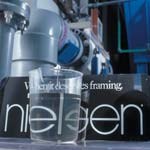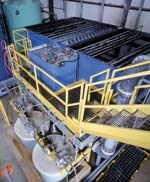Framing Up a New Wastewater Treatment System
An expanding business and budgetary constraints forced Nielsen & Bainbridge to handle its wastewater treatment system expansion more creatively...
The Cumberland River meanders through rolling hills in north central Tennessee past quiet towns and thriving industries such as Nielsen and Bainbridge (N&B), one of the world's leading producers and distributors of high-quality picture framing products. "This is our backyard where we like to fish and boat. This is the river that the city gets our drinking water from," explained Ron Bernhardt, senior engineer at N&B. "We want to be good neighbors. This is beautiful country, and we want to keep it that way."
Given the nature of his employer's business, that's not as easy to do as Mr. Bernhardt's easygoing manner might lead you to think. N&B's Tennessee plant is a 250,000-sq-ft complex of seven buildings where 70% of the world's extruded aluminum picture frames are produced. Operating three shifts, 6 days a week, it is the county's largest employer, with 250 employees.
Each day, the Tennessee plant produces 50 running miles of extruded virgin-aluminum picture frame. These extrusions are cut into 10- and 11-ft lengths. Up to 50 different profiles are extruded from the two machines. One machine is a 2,000-ton press, and the other is a 1,500-ton press.
More than 500 different extrusion profiles and finish combinations are produced, and the company is continually adding more. Approximately 80% of N&B's products are anodized; 20% are primed and painted.
Every month the etching/anodizing process consumes 18,000 gal of caustic soda, 7,000 gal of nitric acid, 8,000 gal of phosphoric acid and 8,000 gal of sulfuric acid. The process involves a 49-tank system using automated cranes to insert and remove racks of extrusions in a precisely timed sequence.
When management foresaw that production would increase 20%, and that more than 50% of the extrusions would now be etched, it knew an entirely new wastewater treatment system would be necessary. Not only was the existing system's 75 gpm capacity far too small to handle the new production level, the increased etching production would contribute even more solids to the waste stream.
Furthermore, production could not be shut down while a new wastewater treatment system was designed and installed. Timing for the new facility had to exactly coincide with the start date chosen for the production startup of the expanded etching operation— that start date was only 5 months away.
Faced with a seemingly impossible task, N&B turned to Water and Wastewater Equipment Company (WWE), whose management team had worked closely with the company on a previous project.
Working in conjunction with Ralph Jones, N&B's director of engineering and quality control (now retired after 20 years), and with Mike McCloskey, WWE's project engineer, the flow rate and solids removal parameters were established for the new system (see Table I). Mr. McCloskey and the WWE design team went to work.
To compound the problems, the design team learned that N&B needed a new building to house the new wastewater treatment plant. Because of budget constraints and the critical timing, the slab for the 3,000-sq-ft treatment plant would be poured months before the walls and roof were erected.
The slab is actually a huge containment vessel, with a sloping surface that feeds into a large sump. From there, if a tank should leak, spill over or other catastrophes occur, fluids are automatically pumped to a holding tank outside the building. Nothing escapes. "We want to be sure that if the unthinkable should happen, our pre-emptive planning will keep everything under control," explained Mr. Bernhardt.
However, the design team had to deal with another complication. N&B decided to install the system itself because of budgetary restrictions requiring the company to use its own resources wherever possible. The contract called for WWE to design the system and supply the tanks, clarifier, filter press and controls, but for N&B's in-house general maintenance crew to install those components, including all pumps and piping.
This meant that the system schematics had to be clearly understood to avoid confusion or installation errors. "The drawings were understandable and easy for our six men to follow. We had no installation problems at all," explained N&B's maintenance manager, Eugene Stibolt, who supervised operation of the plant's original wastewater treatment system and also was responsible for purchasing the new materials.
"We installed the tanks and other major components the moment the trucks delivered them. We didn't have time to wait," explained Mr. Stibolt. "As work progressed on this complex installation, we color-coded the piping to make sure we didn't make any mistakes. It's pretty gaudy looking, but it worked like a charm.
The only "surprise" Mr. Stibolt encountered occurred at the end of the installation process. In addition to the new expandable 60-90-cu-ft filter press, an existing filter press had to be moved to the new waste treatment building. However, to install the old press, several roof panels had to be removed, since the press had to be lowered into its upper-level site by crane.
Both filter presses are sited on the treatment facility's upper level directly over two 20-cu-yd sludge hoppers designed by Mr. Bernhardt. An average of five hopper loads is trucked weekly to a sanitary landfill.
Today the new wastewater treatment plant, designed to handle 300 gpm, is already processing 150 gpm.
| TABLE I—NPDES Discharge Limits for N&B | ||
|
|
||
| Daily Maximum | Monthly Avg. Maximum | |
| TSS | 60 ppm | 31 ppm |
| Oil and Grease | 52 ppm | 26 ppm |
| Total Cyanide | 1.20 ppm | 0.65 ppm |
| Total Aluminum | 10 ppm | N/A |
| Total Cadmium | 0.69 ppm | 0.26 ppm |
| Total Chromium | 2.77 ppm | 1.71 ppm |
| Total Copper | 3.38 ppm | 2.07 ppm |
| Total Lead | 0.69 ppm | 0.43 ppm |
| Total Nickel | 3.98 ppm | 2.38 ppm |
| Total Silver | 0.43 ppm | 0.24 ppm |
| Total Zinc | 2.61 ppm | 1.48 ppm |
| Total Toxic Organics | 2.13 ppm | N/A |
| pH = 6.0 to 9.0 | ||
The system management tasks of Roger Wilson, senior chemical engineer at N&B, are made easier by two pH adjustment tanks and proportioning chemical feed controls. "The first pH adjustment tank enables us to obtain a coarse pH level. The second tank then refines that level to the exact pH we need for the flocculation level we want. It's all automated using sophisticated pH controls," Mr. Wilson explained.
"With the proportioning chemical feed system, the closer the solution approaches the pre-set pH level, the slower the pump operates. There are no wide swings or over-and-under pH readings. This has saved us a sizeable amount in chemical costs and assures consistent chemistry," he added.
"The system saves us even more in chemical costs by allowing us to batch treat etch and anodizing liquids. The solutions neutralize each other and drop out solids more effectively.
We add calcium chloride as a coagulant. We also use a flocculent and sodium hydroxide or sulfuric acid for pH adjustment. How much chemical we use is especially important to us now that we are etching far more of our aluminum extrusions. We have to deal with both a higher level of solids and a higher concentration of aluminum in the effluent.
"By batching our spent anodizing and etching liquids, we reduce aluminum levels in the effluent and stay far below EPA's NPDES requirements. That allows us to discharge directly into the Cumberland River. We don't try to just meet EPA's standards, we manage our operation so that we discharge no more than a quarter of the maximum levels set by EPA," Mr. Wilson proudly noted.
N&B also treats its bright dips, cleaners, deoxidizers, nitric dip and various organic and inorganic dyes and nickel seals.
Mr. Wilson also pointed out that the system's data collection unit charts the effluent pH as well as the volume. They use an ISCO bubbler flow meter/pH data recorder that measures flow rate and pH and records it at programmable intervals. "We are constantly recording what we discharge and how much. We have precise documentation if we are ever asked to verify that we are within compliance."
Read Next
Education Bringing Cleaning to Machining
Debuting new speakers and cleaning technology content during this half-day workshop co-located with IMTS 2024.
Read MoreDelivering Increased Benefits to Greenhouse Films
Baystar's Borstar technology is helping customers deliver better, more reliable production methods to greenhouse agriculture.
Read MoreEpisode 45: An Interview with Chandler Mancuso, MacDermid Envio Solutions
Chandler Mancuso, technical director with MacDermid Envio discusses updating your wastewater treatment system and implementing materials recycling solutions to increase efficiencies, control costs and reduce environmental impact.
Read More















.jpg;maxWidth=300;quality=90)









